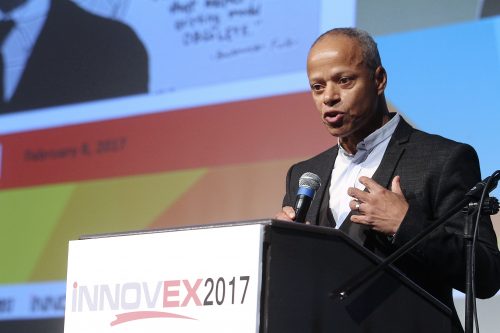This is what Kerry Holley, an expert in cognitive computing and former CTO of IBM and Cisco, says in the plenary of the iNNOVEX2017 conference that took place yesterday at the Avenue Conference Center in Kiryat Airport


Kerry Holley is an expert in cognitive computing. A senior at Optcom, which deals in medical devices, he held a senior position at IBM - an IBM fellow, and was CTO at IBM and Cisco.
At the iNNOVEX2017 conference held yesterday at the Avenue Convention Center chaired by ASG CEO Shlomo Gerdman and Dr. Yossi Vardi, he addressed the implications of the development of artificial intelligence and cognitive computing.
The 2017 Davos conference dealt with cognitive computing. A year earlier, the same conference discussed the fourth computer revolution. No matter how you call the revolution - some call it a singularity, meaning the meeting between the physical, biological and digital worlds.
"Already two years ago, we were able to demonstrate building an online store in five days using public APIs: storage space on Amazon, product photos (clothes in this case) on Instagram, payments on PayPal and more. The website takes advantage of the capabilities that exist today in analytics, mobility, cloud, social networks and can grow to hundreds of thousands of users and we didn't have to buy software and hardware from suppliers. Today, it might be possible to build the same store in a much shorter time and the capabilities of these systems - for example, the ability to understand the customer's requirements through artificial intelligence."
"The first computing revolution was the birth of the mainframe in the XNUMXs, the personal computer in the XNUMXs, the client-server in the XNUMXs, the Internet in the XNUMXs and now the cognitive age based on clouds and virtual machines, a world where the modern organization builds software in a different way than before."
"We are also in the second wave of digitization. The first stage is the introduction of connectivity to existing consumer products, but the Internet of Things is only at the beginning stage. Just as in 1995 we did not understand the full potential of the Internet that we see today - we had very little imagination about the companies that dominate today such as Facebook, Google and Amazon. We are at the same turning point in IoT.”
"We are seeing a merging of three worlds: the world of IT systems, the world of people and the physical world we live in which is linked through cameras, sensors and more. For decades we transferred the data to a data center and processed it centrally. Today, computing is pushed out back to the factory, to the field or wherever it is needed. We need enormous computing power to perform the processing."
"Many ask what is the difference between artificial intelligence and cognitive computing. If you listen to Jeannie Rometty, CEO of IBM, she defines cognitive computing as a pooling of many components of artificial intelligence, but in my opinion they have instilled in us that artificial intelligence is a threat, so we are looking for other terminology."
"As for that threat, there is a difference between soft artificial intelligence and hard artificial intelligence. With hard artificial intelligence, we will really have a hard time distinguishing whether a certain action was done by a human or a computer. We are starting to see buds of soft artificial intelligence such as Siri, Alexa or Cortana. No one expects these systems to understand one hundred percent."
"It will be difficult to achieve hard artificial intelligence, just as we do not know much about the Milky Way - the galaxy we live in, so we know very little about the human brain. We do not know but only speculate how many neurons and how many connections there are in the brain. It will take a long time before we can mimic the human brain. In 2011, when IBM first introduced Watson, it contained 2,500 processors running at the same time. Today, the same operation can be compressed in less space and must be done because more processing power is needed at the edge, there is not enough bandwidth to transfer processing to the cloud. An example of this is the autonomous cars. The processing must be done in a fraction of a second in the car itself. There is not enough bandwidth to constantly send images to the cloud that will recognize that it is a motorcycle rider cutting you off at a speed of 120 km/h."
"Artificial intelligence was in the XNUMXs and machine learning has been around since the XNUMXs. Beware of vendors who package XNUMXs technology as artificial intelligence. The difference between then and now: deep learning. We are beginning to see the beginnings of emotion recognition, so for example a blind person will be able to tell with smart glasses what the emotions of the person standing in front of him are."
"We are starting to see this in areas such as transportation, oil, health. Virtual reality games, bots and personal assistants. Why do technology companies invest in artificial intelligence because they want to reach a world where computing can sense our presence and work together with us."
"Machine-to-machine communication and the Internet of Things will be mandatory in every factory. Traditional companies are facing an industrial revolution, which means that entire industries are merging and companies that were not competing suddenly find themselves competing against companies that were considered companies in a distant field. The area in which Holly recommends focusing now on the introduction of artificial intelligence is the health sector. It has a lot of money, and it needs many solutions."
